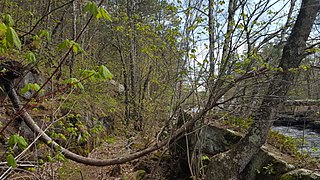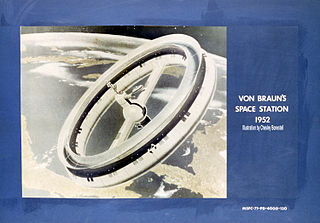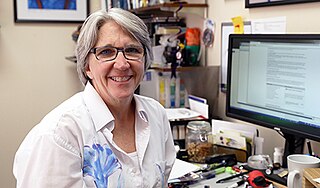Isaac Newton's rotating bucket argument was designed to demonstrate that true rotational motion cannot be defined as the relative rotation of the body with respect to the immediately surrounding bodies. It is one of five arguments from the "properties, causes, and effects" of "true motion and rest" that support his contention that, in general, true motion and rest cannot be defined as special instances of motion or rest relative to other bodies, but instead can be defined only by reference to absolute space. Alternatively, these experiments provide an operational definition of what is meant by "absolute rotation", and do not pretend to address the question of "rotation relative to what?" General relativity dispenses with absolute space and with physics whose cause is external to the system, with the concept of geodesics of spacetime.

In physics, the Coriolis force is an inertial or fictitious force that acts on objects in motion within a frame of reference that rotates with respect to an inertial frame. In a reference frame with clockwise rotation, the force acts to the left of the motion of the object. In one with anticlockwise rotation, the force acts to the right. Deflection of an object due to the Coriolis force is called the Coriolis effect. Though recognized previously by others, the mathematical expression for the Coriolis force appeared in an 1835 paper by French scientist Gaspard-Gustave de Coriolis, in connection with the theory of water wheels. Early in the 20th century, the term Coriolis force began to be used in connection with meteorology.

The sense of balance or equilibrioception is the perception of balance and spatial orientation. It helps prevent humans and nonhuman animals from falling over when standing or moving. Equilibrioception is the result of a number of sensory systems working together; the eyes, the inner ears, and the body's sense of where it is in space (proprioception) ideally need to be intact.

A centrifuge is a device that uses centrifugal force to subject a specimen to a specified constant force, for example to separate various components of a fluid. This is achieved by spinning the fluid at high speed within a container, thereby separating fluids of different densities or liquids from solids. It works by causing denser substances and particles to move outward in the radial direction. At the same time, objects that are less dense are displaced and moved to the centre. In a laboratory centrifuge that uses sample tubes, the radial acceleration causes denser particles to settle to the bottom of the tube, while low-density substances rise to the top. A centrifuge can be a very effective filter that separates contaminants from the main body of fluid.
An equatorial bulge is a difference between the equatorial and polar diameters of a planet, due to the centrifugal force exerted by the rotation about the body's axis. A rotating body tends to form an oblate spheroid rather than a sphere.

Centrifugation is a mechanical process which involves the use of the centrifugal force to separate particles from a solution according to their size, shape, density, medium viscosity and rotor speed. The denser components of the mixture migrate away from the axis of the centrifuge, while the less dense components of the mixture migrate towards the axis. Chemists and biologists may increase the effective gravitational force of the test tube so that the precipitate (pellet) will travel quickly and fully to the bottom of the tube. The remaining liquid that lies above the precipitate is called a supernatant or supernate.

Artificial gravity is the creation of an inertial force that mimics the effects of a gravitational force, usually by rotation. Artificial gravity, or rotational gravity, is thus the appearance of a centrifugal force in a rotating frame of reference, as opposed to the force experienced in linear acceleration, which by the equivalence principle is indistinguishable from gravity. In a more general sense, "artificial gravity" may also refer to the effect of linear acceleration, e.g. by means of a rocket engine.

Gravitropism is a coordinated process of differential growth by a plant in response to gravity pulling on it. It also occurs in fungi. Gravity can be either "artificial gravity" or natural gravity. It is a general feature of all higher and many lower plants as well as other organisms. Charles Darwin was one of the first to scientifically document that roots show positive gravitropism and stems show negative gravitropism. That is, roots grow in the direction of gravitational pull and stems grow in the opposite direction. This behavior can be easily demonstrated with any potted plant. When laid onto its side, the growing parts of the stem begin to display negative gravitropism, growing upwards. Herbaceous (non-woody) stems are capable of a degree of actual bending, but most of the redirected movement occurs as a consequence of root or stem growth outside. The mechanism is based on the Cholodny–Went model which was proposed in 1927, and has since been modified. Although the model has been criticized and continues to be refined, it has largely stood the test of time.
Gravitational biology is the study of the effects gravity has on living organisms. Throughout the history of the Earth life has evolved to survive changing conditions, such as changes in the climate and habitat. However, one constant factor in evolution since life first began on Earth is the force of gravity. As a consequence, all biological processes are accustomed to the ever-present force of gravity and even small variations in this force can have significant impact on the health and function and the system of organisms.

Stellar rotation is the angular motion of a star about its axis. The rate of rotation can be measured from the spectrum of the star, or by timing the movements of active features on the surface.

A rotating wheel space station, also known as a von Braun wheel, is a concept for a hypothetical wheel-shaped space station. Originally proposed by Konstantin Tsiolkovsky in 1903, the idea was expanded by Herman Potočnik in 1929.

Weightlessness is the complete or near-complete absence of the sensation of weight. It is also termed zero gravity, zero G-force, or zero-G. Micro-g environment is more or less synonymous, with the recognition that g-forces are never exactly zero.

A random positioning machine, or RPM, rotates biological samples along two independent axes to change their orientation in space in complex ways and so eliminate the effect of gravity.
The free fall machine (FFM) is designed to permit the development of small biological sample such as cell cultures with a simulated effect of micro-gravity, under free fall conditions.

In Newtonian mechanics, the centrifugal force is an inertial force that appears to act on all objects when viewed in a rotating frame of reference. It is directed away from an axis which is parallel to the axis of rotation and passing through the coordinate system's origin. If the axis of rotation passes through the coordinate system's origin, the centrifugal force is directed radially outwards from that axis. The magnitude of centrifugal force F on an object of mass m at the distance r from the origin of a frame of reference rotating with angular velocity ω is:

Statocytes are gravity-sensing (gravitropic) cells in higher plants. They contain amyloplasts-statoliths – starch-filled amyloplastic organelles – which sediment at the lowest part of the cells. In the roots, sedimentation of the statoliths towards the lower part of the statocytes constitutes a signal for the production and redistribution of auxin. When stems or roots are not exactly aligned with the gravity vector, statoliths move and adjust to gravity. This is followed by a triggering of the asymmetrical distribution of auxin that causes the curvature and growth of stems against the gravity vector, as well as growth of roots along the gravity vector. Statocytes are present in the elongating region of coleoptiles, shoots and inflorescence stems. In roots, the root cap is the only place where sedimentation is observed, and only the central columella cells of the root cap serve as gravity-sensing statocytes. They can initiate differential growth patterns, bending the root towards the vertical axis.
Space neuroscience or astroneuroscience is the scientific study of the central nervous system (CNS) functions during spaceflight. Living systems can integrate the inputs from the senses to navigate in their environment and to coordinate posture, locomotion, and eye movements. Gravity has a fundamental role in controlling these functions. In weightlessness during spaceflight, integrating the sensory inputs and coordinating motor responses is harder to do because gravity is no longer sensed during free-fall. For example, the otolith organs of the vestibular system no longer signal head tilt relative to gravity when standing. However, they can still sense head translation during body motion. Ambiguities and changes in how the gravitational input is processed can lead to potential errors in perception, which affects spatial orientation and mental representation. Dysfunctions of the vestibular system are common during and immediately after spaceflight, such as space motion sickness in orbit and balance disorders after return to Earth.
In astronomy, geography, and related sciences and contexts, a direction or plane passing by a given point is said to be vertical if it contains the local gravity direction at that point. Conversely, a direction or plane is said to be horizontal if it is perpendicular to the vertical direction. In general, something that is vertical can be drawn from up to down, such as the y-axis in the Cartesian coordinate system.

Sarah Wyatt is an American, plant molecular biologist. She is a Professor in the Department of Environmental and Plant Biology at Ohio University, as well as director of the Ohio University Interdisciplinary Graduate Program in Molecular and Cellular Biology. Wyatt's research interests include molecular biology, genomics, and signaling events. She is considered one of the world's experts on gravitational signaling in plants, and some of her recent research includes an experiment on board the International Space Station (ISS).
The large diameter centrifuge, or LDC, is any centrifuge extending several meters, which can rotate samples to change their acceleration in space to enhance the effect of gravity. Large diameter centrifuges are used to understand the effect of hyper-gravity on biological samples, including and not limiting to plants, organs, bacteria, and astronauts or non-biological samples to undertake experiments in the field of fluid dynamics, geology, biochemistry and more.












